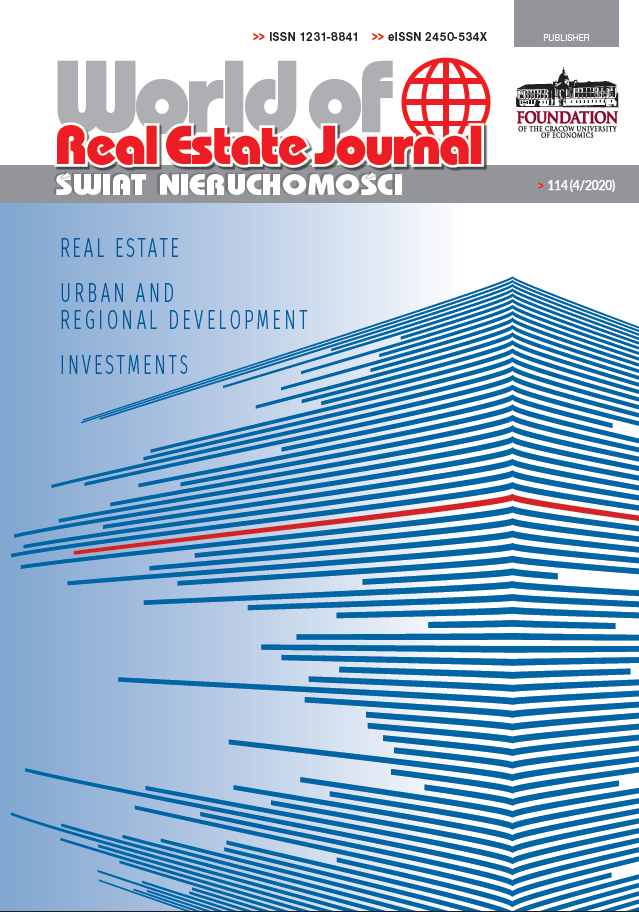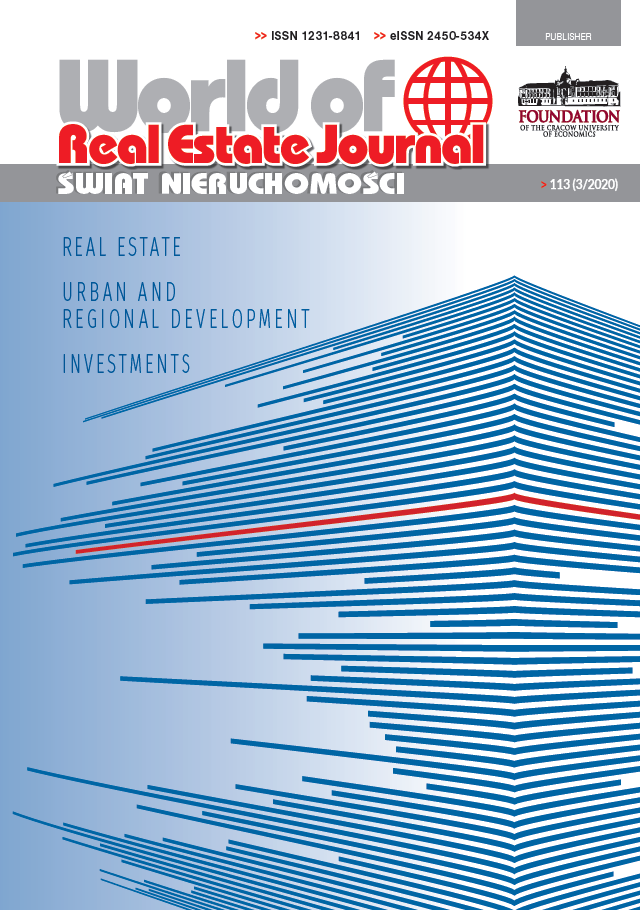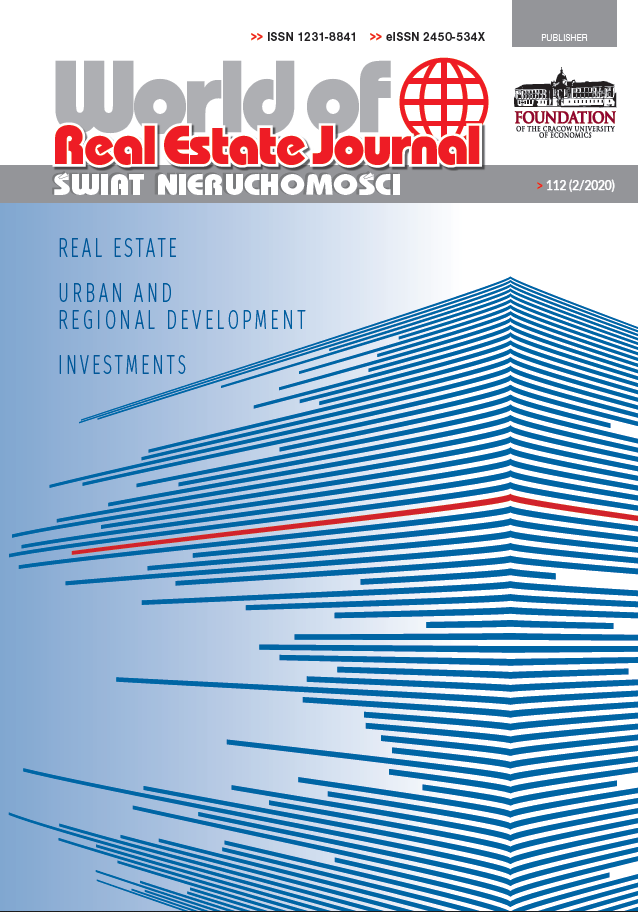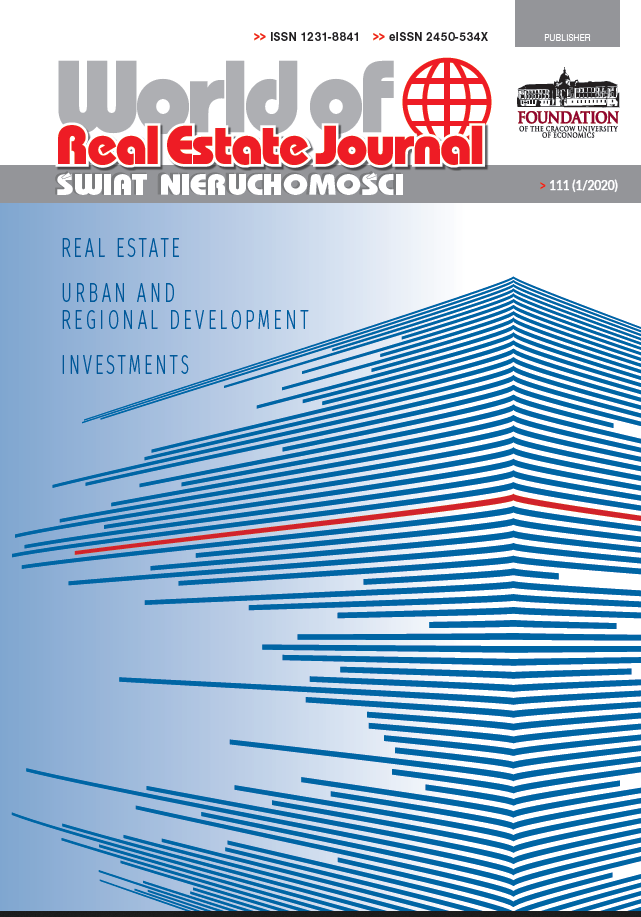PROBLEMS OF URBAN DEVELOPMENT
1) Janusz Jeżak, Maciej W. Wierzchowski – Urbanisation needs for housing in Poland by 2013
2) Bogusław Luchter – Land use changes in Kraków Śródmieście
3) Zbigniew Makieła, Anna Pogłódek – Gated communities in the urban space of Krakow
MARKET
4) Jowita Pustuł – Sale of real estate – VAT consequences
5) Krzysztof Nowak – Relationship between fluctuations of stock indies and changes if flat’s prices in Poland
6) Sonia Huderek-Glapska – The impact of aircraft noise on residential real estate prices in Warsaw – the stated preferences analysis
FINANCES
7) Bartosz Betka, Łukasz Borkowski – The financial sector as an external environment of small and medium sized construction enterprises during crisis
8) Maciej Mańkowski, Mateusz Mikołajczak – Size and property portfolio diversification in the modern portfolio theory context
CHANGES IN REAL ESTATE LAW
9) Maciej J. Nowak – Action against the resolution on the zoning preparaiton proceedings DOWNLOAD
CONFERENCES
10) Małgorzata Zięba – INNOVATIVE TRENDS IN CONSTRUCTION AND REAL ESTATE SECTOR (ITCRES 2013): International Scientific Conference on Real Estate, Management, Technology, Innovations and Education (Bratyslava, Slowakia, 9th - 10th May 2013) DOWNLOAD
11) Katarzyna Najbar – 21st Scientifica Conference of Real Estate Scientific Society (Wrocław, 27th -29th May 2013) DOWNLOAD
12) Katarzyna Kania – 20th Conference of European Real Estate Society (Vienna, Austria, 3rd -6th July 2013) DOWNLOAD
PROFILES
13) Laudation on the jubilee of the 50th anniversary of Professor Halina Henzel's academic career DOWNLOAD
SUMMARIES
Janusz Jeżak, Maciej W. Wierzchowski - Urbanisation needs for housing in Poland by 2013
Assessments presented in the article are based on research conducted by the Institute of Urban Development. The study was an attempt to answer the question: What are the determinants of land management in Poland? Research in this field should be continued in relation to the ‘Polska 2030’ (Poland 2030) concept of spacial planning. Housing development demand for urban areas is primarily affected by the urban planning standards used in defining the indicator of built-up areas, implemented in practice, forming a specific pattern - benchmark. Such a pattern was used for the estimation of urbanization needs with an indicator method. Assuming that there are conditions to achieve about 75% of the investments in construction areas equipped with the necessary technical and social infrastructure, the rational, average annual demand for new residential areas will be 2.6 thousand ha, and the total – a twenty-year 52.5 thousand ha. A partial reduction of dispersed urbanization in favour of compact urbanization (including compact urbanisation using the revitalization and re-urbanization) gives the possibility to limit the expansion of residential areas by about 20%, which means to the level of 42 thousand ha. Such specified needs were compared to the estimations conducted with a method of historical analogy, which identified the increase of residential areas by 2030 at a similar level of 54.4 thousand ha.
Key words: needs of urbanization; land use; land for housing; spatial planning; building distributed; compact buildings
Citation (APA): Jeżak, J., Wierzchowski, M.W. (2013). Potrzeby urbanizacyjne mieszkalnictwa w Polsce do 2030 roku. Świat Nieruchomości, (3(85)), 4-11.
DOI: 10.14659/worej.2013.85.01
Bogusław Luchter - Land use changes in Kraków Śródmieście
The aim of this article is to evaluate the process of land use changes occurring in the initial period of implementation of principles of the market economy within one of the regular urban units of the former cadastral district I of the city of Cracow – Śródmieście, formed as early as in the Middle Ages. A study was conducted in a system of legally and functionally diverse allotments, within 20 years - i.e. 1992-2012. The study revealed mostly qualitative changes. They involved,among other things, a decrease of the surface of areas for residential development and the increase in the surface of the socalled multifunctional complexes (i.e. residential and commercial buildings). In the case of commercial areas, a decrease of the surface of territories occupied in basic services (e.g. trade) was observed in favour of high priority services, related to the strengthening of the major functions of Cracow: culture, science and tourism.
Key words: Land use changes; Kraków; multifunctional complexes
Citation (APA): Luchter, B. (2013). Przemiany użytkowania ziemi na terenie śródmieścia Krakowa. Świat Nieruchomości, (3(85)), 12-19.
DOI: 10.14659/worej.2013.85.02
Zbigniew Makieła, Anna Pogłódek - Gated communities in the urban space of Krakow
The characteristic feature of „gated communities” in Cracow is the fact that they satisfy the needs of residents, that is individuality, security and contact with nature. Closed “gated communities” form enclaves with a typical kind of building system in the form of a nest. Residential buildings surround a common square and are situated in such a way that they form small courtyards, which are partially or almost completely closed. In this area the public space is concentrated, including playgrounds, squares, promenades, bicycle paths and parking places. The urban features of the „gated communities” include the modernity of buildings, a high standard of building equipment and high aesthetics. An essentially urban feature of the „gated communities” is the fact that the buildings erected in their areas have smaller cubic capacity than traditional urban buildings, with fewer apartments and commercial premises.
Key words: lifestyle gated communities ;security zone gated communities; lifestyle gated communities; gated communities; urban space
Citation (APA): Makieła, Z., Podgłódek, A. (2013). Gated communities w przestrzeni miejskiej Krakowa. Świat Nieruchomości, (3(85)), 20-27.
DOI: 10.14659/worej.2013.85.03
Jowita Pustuł - Sale of real estate – VAT consequences
Should the sale of a real estate be treated as a VAT taxable transaction or as a transaction which is exempt from VAT ? The answer to this question is crucial not only for a property seller, but also for an acquirer. If it turned out that the seller wrongly assumed that the transaction was exempt from VAT , tax arrears would arise and he would have to settle the arrears with penalty interest. However, if he wrongly treated the transaction as VAT taxable, the acquirer would be put at tax risk. According to Article 88 section 3a point 2 of the VAT Act, the taxpayer is not allowed to deduct input tax if a transaction was not taxable. In this article the basic principles of VAT taxation applicable in the sale of real estate process were discussed.
Key words: sale; real estate; VAT; taxable transaction; exemption; tax
Citation (APA): Pustuł, J. (2013). Sprzedaż nieruchomości – konsekwencje dla podatku do towarów i usług. Świat Nieruchomości, (3(85)), 28-33.
DOI: 10.14659/worej.2013.85.04
Krzysztof Nowak - Relationship between fluctuations of stock indies and changes if flat’s prices in Poland
Real estate is nowadays increasingly treated as capital investment.Today investments in the property market can be both direct and by means of instruments indirectly linked with it. One of the most important advantages of direct investment in real estate frequently mentioned in literature is a low correlation between returns on such investments and returns on equities and bonds. Thanks to this fact, direct investment in real estate can be a useful tool that could help to diversify the portfolio of securities on stock exchange. This article presents the results of a study whether over the last few years there was a correlation between fluctuations of two main indices listed on the Warsaw Stock Exchange and fluctuations of average flat prices in the major Polish cities. Moreover, it was examined which type of assets was of lower risk at that time.
Key words: flat; investment; diversification; correlation
Citation (APA): Nowak, K. (2013). Wahania indeksów giełdowych w Polsce a zmiany cen mieszkań. Świat Nieruchomości, (3(85)), 34-39.
DOI: 10.14659/worej.2013.85.05
Sonia Huderek- Glapska - The impact of aircraft noise on residential real estate prices in Warsaw– the stated preferences analysis
The paper presents the results of a research on the impact of aircraft noise associated with the Warsaw Chopin Airport operation on the prices of residential real estate situated within the limited use area. The method used in the study is the analysis of stated preferences of buyers of property located within the airport impact area. The research is based on a survey with developers who made investments in the limited use area. The results show that the value of a discount at which residential property exposed to aircraft noise was sold, in comparison to property with similar characteristics located outside the airport impact area, depends on the noise intensity. According to the developers’ opinion, the values of residential real estate exposed to aircraft noise, but located further away from the airport than those from Z1 and Z2 zones, are not likely to decrease.
Key words: Aircraft noise; real estate; preferences
Citation (APA): Huderek-Glapska, S. (2013). Wpływ hałasu lotniczego na ceny mieszkań w Warszawie na podstawie deklarowanych preferencji. Świat Nieruchomości, (3(85)), 40-45.
DOI: 10.14659/worej.2013.85.06
Bartosz Betka, Łukasz Borkowski - The financial sector as an external environment of small and medium sized construction enterprises during crisis
Beyond a shadow of a doubt there are strong connections and mutual relations between the financial market, real estate market and building sector enterprises (especially small and medium enterprises). Visible is also the influence of government policies and laws made by parliaments on the above mentioned (e.g. regulations concerning mortgages). Connections between enterprises active on real estate market have crucial impact on real estate market cycles. The real estate market crises are less popular, because of the fact that they appear rarely as a part of the economic crisis. Nonetheless, a deterioration in this field of market has been spotted recently as well. The aim of this article is to describe the current situation on the real estate market in Poland, bearing in mind all the negative aspects of the economic crisis. The key conclusions and recommendations are presented in the concise summary.
Key words: real estate market; economic crisis; financial market; mortgage
Citation (APA): Betka, B., Borkowski, Ł. (2013). Sektor finansowy jako otoczenie zewnętrzne przedsiębiorstw budowalnych podczas kryzysu. Świat Nieruchomości, (3(85)), 46-56.
DOI: 10.14659/worej.2013.85.07
Maciej Mańkowski, Mateusz Mikołajczak - Size and property portfolio diversification in the modern portfolio theory context
This is the first article in Poland that discusses the problemof impact of property portfolio size on investment risk reduction. The rates of return and the risk of obtaining them for 112 properties of various designations in Cracow were analysed in the context of Modern Portfolio Theory. A variety of portfolios were designed, using different methods of selecting real estate. It was found that a greater number of portfolio components reduce the risk more efficiently than a smaller number of portfolio components. Studies have shown that the portfolio construction approach based on the selection of the most risky assets is characterized by a markedly higher risk compared with other methods (i.e. random selection and averaging). Regardless of the adopted criterion of the selection of components, the most effective risk reduction is in the range of 12-14 properties, and further portfolio size increase is inefficient for investments.
Key words: diversification; risk reduction; property portfolio; Modern Portfolio Theory; portfolio size
Citation (APA): Mańkowski, M., Mikołajczak, M. (2013). Dywersyfikacja portfela nieruchomości w świetle nowoczesnej teorii portfelowej. Świat Nieruchomości, (3(85)), 57-63.
DOI: 10.14659/worej.2013.85.08





















































